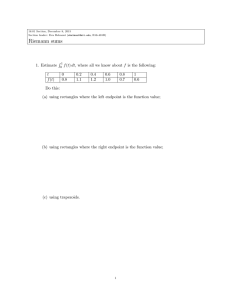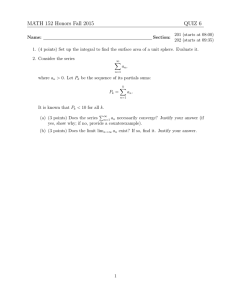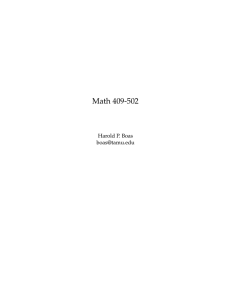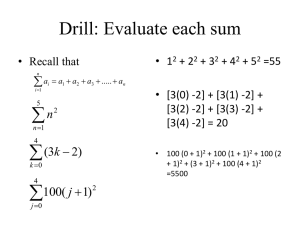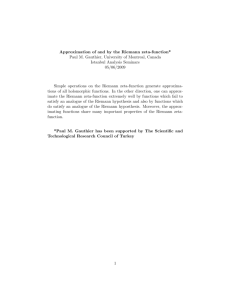MATH 18.01 - MIDTERM 3 - SOME REVIEW PROBLEMS WITH SOLUTIONS
advertisement
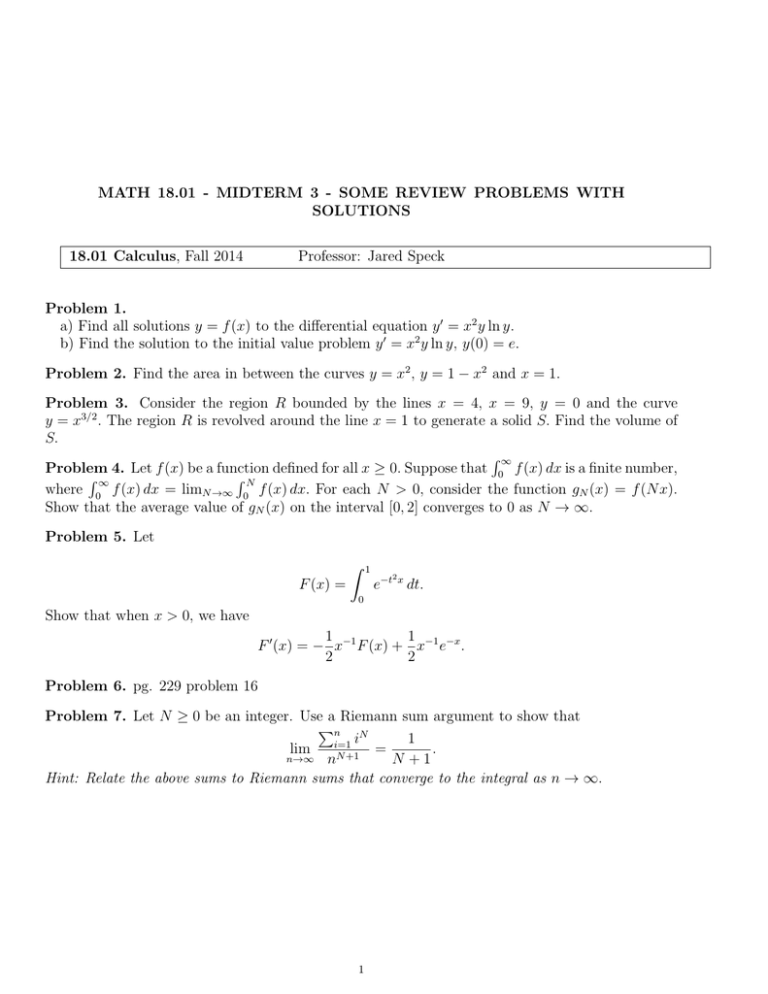
MATH 18.01 - MIDTERM 3 - SOME REVIEW PROBLEMS WITH SOLUTIONS 18.01 Calculus, Fall 2014 Professor: Jared Speck Problem 1. a) Find all solutions y = f (x) to the differential equation y 0 = x2 y ln y. b) Find the solution to the initial value problem y 0 = x2 y ln y, y(0) = e. Problem 2. Find the area in between the curves y = x2 , y = 1 − x2 and x = 1. Problem 3. Consider the region R bounded by the lines x = 4, x = 9, y = 0 and the curve y = x3/2 . The region R is revolved around the line x = 1 to generate a solid S. Find the volume of S. R∞ Problem 4. Let f (x) be a function defined for all x ≥ 0. Suppose that 0 f (x) dx is a finite number, R∞ RN where 0 f (x) dx = limN →∞ 0 f (x) dx. For each N > 0, consider the function gN (x) = f (N x). Show that the average value of gN (x) on the interval [0, 2] converges to 0 as N → ∞. Problem 5. Let 1 Z 2 e−t x dt. F (x) = 0 Show that when x > 0, we have 1 1 F 0 (x) = − x−1 F (x) + x−1 e−x . 2 2 Problem 6. pg. 229 problem 16 Problem 7. Let N ≥ 0 be an integer. Use a Riemann sum argument to show that Pn N 1 i=1 i lim = . N +1 n→∞ n N +1 Hint: Relate the above sums to Riemann sums that converge to the integral as n → ∞. 1 2 MATH 18.01 - MIDTERM 3 - SOME REVIEW PROBLEMS WITH SOLUTIONS Problem 1. a) Find all solutions y = f (x) to the differential equation y 0 = x2 y ln y. Solution: We first write the differential equation as dy = x2 dx. y ln y We now integrate both sides and use the substitution u = ln y, du = y1 dy to deduce that 1 ln | ln y| = x3 + C. 3 Exponentiating twice, we deduce that (1/3)x3 y = ece , C c = ±e . b) Find the solution to the initial value problem y 0 = x2 y ln y, y(0) = e. Solution: We have to solve for c. Setting x = 0, y = e in the above formula for y in terms of x, we deduce that (1/3)03 e = ece = ec , (1/3)x3 which implies that c = 1. The solution is therefore y = ee . Problem 2. Find the area in between the curves y = x2 , y = 1 − x2 and x = 1. Solution: The graphs of y = x2 , y = 1 − x2 intersect when x2 = 1 − x2 , or equivalently, when 2x2 = 1. This equation has the solutions r 1 . x=± 2 q q q The region of interest can be split into two regions: − 12 ≤ x ≤ 12 and 12 ≤ x ≤ 1. In the first region, the top curve is y = 1 − x2 and the bottom one is y = x2 . The area of this region is therefore √ 12 Z √1 2 2 3 2 2 √ 1 (1 − x ) − x dx = x − 3 x √ 1 − 2 − 2 4 = √ . 3 2 In the second region, the top curve is y = x2 and the bottom one is y = 1 − x2 . The area of this region is therefore 1 Z 1 2 3 2 2 √ 1 x − (1 − x ) dx = 3 x − x √ 1 2 2 1 2 =− + √ . 3 3 2 MATH 18.01 - MIDTERM 3 - SOME REVIEW PROBLEMS WITH SOLUTIONS 3 Therefore, the total area of the two regions is √ 4 2 1 1 √ − + √ = 2− . 3 3 2 3 3 2 Problem 3. Consider the region R bounded by the lines x = 4, x = 9, y = 0 and the curve y = x3/2 . The region R is revolved around the line x = 1 to generate a solid S. Find the volume of S. Solution: We divide S into cylindrical shells whose axes are parallel to the y−axis. For 4 ≤ x ≤ 9, each shell has a height x3/2 , a radius x − 1, and a width dx. Thus, the volume of the shell is dV = 2π(x − 1)x3/2 dx. To find the volume V of S, we integrate dV : Z Z x=9 2π(x − 1)x3/2 dx V = dV = x=4 Z x=9 Z x=9 5/2 = 2π x dx − 2π x3/2 dx x=4 x=4 x=9 2 2 = 2π x7/2 − x5/2 7 5 x=4 2 7 2 7 2 5 2 5 = 2π 3 − 2 − 3 + 2 . 7 7 5 5 R∞ Problem 4. Let f (x) be a function defined for all x ≥ 0. Suppose that 0 f (x) dx is a finite number, R∞ RN where 0 f (x) dx = limN →∞ 0 f (x) dx. For each N > 0, consider the function gN (x) = f (N x). Show that the average value of gN (x) on the interval [0, 2] converges to 0 as N → ∞. R2 R2 Solution: By definition, the average value of gN (x) on [0, 2] is 21 0 gN (x) dx = 12 0 f (N x) dx. By making the substitution u = N x, du = N dx, we see that the average value of gN is Z u=2N 1 f (u) du. 2N u=0 R u=2N By assumption, we have that limN →∞ u=0 f (u) du = I, where I is some finite number. Therefore, it follows that Z u=2N 1 lim f (u) du N →∞ 2N u=0 Z u=2N 1 = lim × lim f (u) du N →∞ 2N N →∞ u=0 =0×I =0 as desired. Problem 5. Let Z F (x) = 0 1 2 e−t x dt. 4 MATH 18.01 - MIDTERM 3 - SOME REVIEW PROBLEMS WITH SOLUTIONS Show that when x > 0, we have 1 1 F 0 (x) = − x−1 F (x) + x−1 e−x . 2 2 √ √ Solution: We make the change of variables u = t x, du = dt x. Then we have the identity Z 1 Z √x 2 2 e−t x dt = x−1/2 F (x) = e−u du. 0 0 We now use the product rule, the second fundamental theorem of calculus, and the chain rule to deduce that ! Z √x d −1/2 −u2 0 x e F (x) = du dx 0 Z √x Z √x d −1/2 2 −u2 −1/2 d e e−u du = x du + x dx dx 0 0 Z √x √ 2 d √ 1 2 x = − x−3/2 e−u du + x−1/2 e−( x) 2 dx 0 Z √x √ 2 1 −3/2 1 2 =− x e−u du + x−1 e−( x) 2 2 0 Z √x 1 1 2 e−u du + x−1 e−x = − x−3/2 2 2 0 1 1 = − x−1 F (x) + x−1 e−x 2 2 as desired. Problem 6. pg. 229 problem 16 Solution: We first calculate the area A(r) of the square cross section of the solid that is located a perpendicular distance r from the center of the wooden sphere (where 0 ≤ r ≤ a accounts for half of√the solid). By the pythagorean theorem, the diagonal length of the square cross section is d = 2 a2 − r2 . Since the area A of a square with a diagonal of length d is A = d2 /2, it follows that A(r) = 2(a2 − r2 ). Therefore, the volume of a thin slice of width dr is A(r) dr. By symmetry, to find the total volume, we can double the volume of one half of the solid (which is obtained by integrating A(r) dr from r = 0 to r = a): Z a V =2 2(a2 − r2 ) dr r=0 r=a 1 3 2 =4 a r− r 3 r=0 8 = a3 . 3 MATH 18.01 - MIDTERM 3 - SOME REVIEW PROBLEMS WITH SOLUTIONS 5 Problem 7. Let N ≥ 0 be an integer. Use a Riemann sum argument to show that Pn N 1 i=1 i lim . = n→∞ nN +1 N +1 Hint: Relate the above sums to Riemann sums that converge to the integral as n → ∞. We first note that Z 1 1 . N +1 0 We then approximate the integral using right Riemann sums with n equal intervals. More precisely, let f (x) = xN . Then with ∆x = 1/n, the right Riemann sum is n n N X X i 1 f (i/n)∆x = n n i=1 i=1 Pn N i . = i=1 N +1 n As n → ∞, the Riemann rectangles become infinitely thin and the Riemann sums converge to the integral N1+1 . That is, Pn N 1 i=1 i lim = N +1 n→∞ n N +1 as desired. xN dx =
